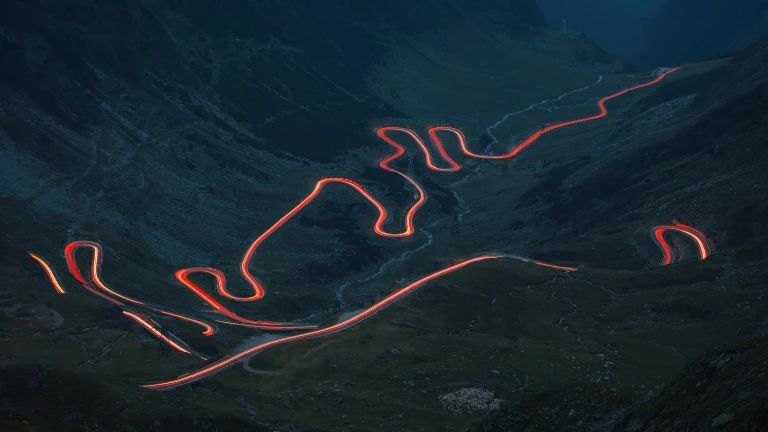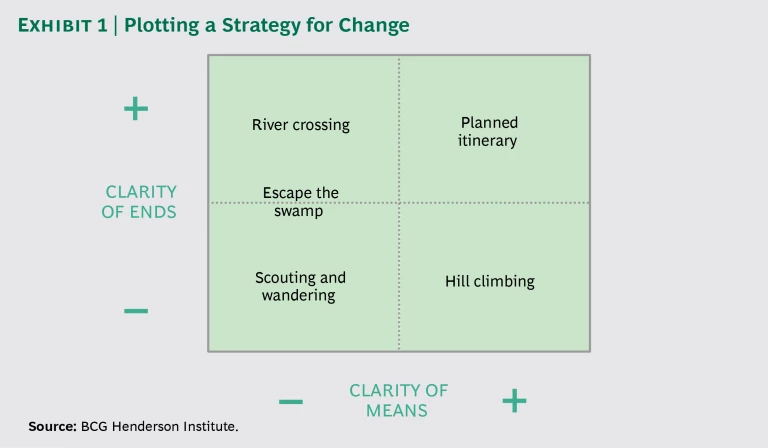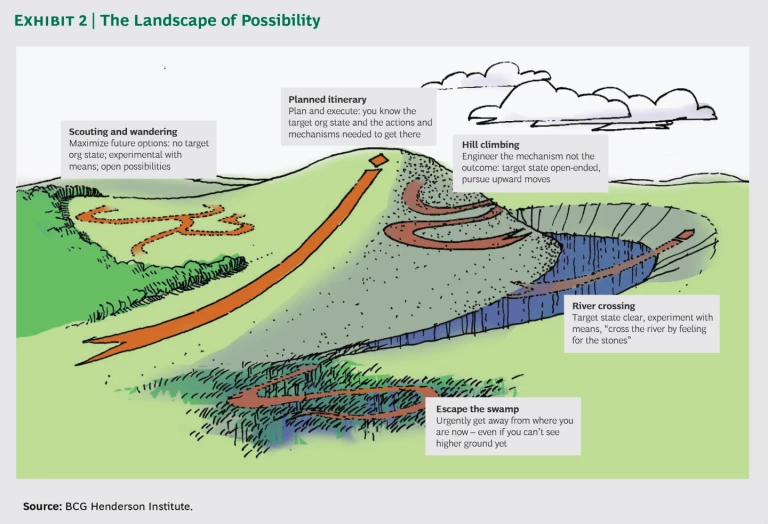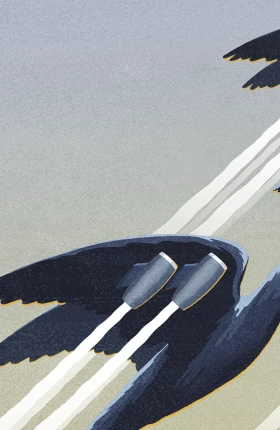Companies frequently need to change themselves, in more or less dramatic ways. If change is ambitious with respect to degree or timescale, we often call it “transformation.” This is a difficult process that often does not work: our research shows that even with modest criteria, only about one-quarter of transformations succeed.
The standard approach to organizational change is a linear project management mindset: define the target state of the organization, determine the logical sequence of action steps, then execute. In reality, though, there are many different kinds of change, each with its own requirements and risks. There are different types of transformations and different components of change within each. General advice on how to do transformation well risks ignoring this variety of potential change strategies. A better approach is to de-average transformation into its different components and ask, what does it take to succeed in each?
The Landscape of Possibility
One way of describing change comes from evolutionary biology. Change can be understood as movement across a “landscape of possibility,” where each point on the landscape corresponds to a possible state of an organization. Higher organizational performance corresponds to greater “height” in the landscape. In pursuing organizational change, we might have a vision of a specific peak and set a course toward it, or we might be tracking upward along an unclear path, and so on.
In business as in evolutionary biology, the topography of our landscape is also shifting. As the economy and competitive conditions change over time, new peaks may rise up (perhaps enabled by new technologies), or new clear paths might open (perhaps enabled by new practices).
Using this framework we can investigate the various strategies for pursuing organizational change, the context in which each is appropriate, and the tactics required to succeed in each.
In particular, we can consider these change strategies along two axes: the clarity we have about the ends (the target state for the organization), and the clarity we have about the means to get there. (See Exhibit 1.)
Change Strategies and Tactics
Each of these strategies represents a different kind of journey across the landscape of possibility. Below, we discuss different change strategies, when they should be applied, as well as the tactics required to succeed in each. (See Exhibit 2.)
Change Strategy 1: Planned Itinerary
Perhaps the most familiar strategy of change is the “planned itinerary.” The strategy is based on a clear idea of both the end and the means. Driven by a vision of a destination, we aim to follow a precisely planned path toward it.
This approach sounds ideal: it is predictable, readily comprehensible, and easily communicable to employees and investors. Indeed, we have an innate tendency to think in terms of planned itineraries. Psychological research suggests that our default interpretive frame is to look for a goal and a series of actions that lead to that end. Even if a clear goal or path does not exist, we may invent these components to rationalize our thought process.
Yet the appeal of this strategy might tempt us to apply it even in situations where it is not warranted. We may believe that if we do A and B our organization will reach its predetermined destination, but in practice, the path turns out to be more complicated. In uncertain circumstances, the confidently crafted plan becomes detrimental. To illustrate, a health insurance company might aim to digitize all of its customer transactions. The CEO puts forward an itinerary with a timeline of actions and sensible intended outcomes, but the actual rollout of the new system causes unpredicted interdepartmental confusion and delays for customers.
We should be careful to apply this approach only when we are justifiably confident that the known means will achieve a predefined goal. For example, in 2016 Staples set out to reduce the costs of goods sold by negotiating with its suppliers. The target was clear: save $250 million across its inventory. And the means were well-known and reliable: list all the currently sold products, request proposals from alternative suppliers, and negotiate with them to reduce costs. The expected savings could be estimated with reasonable accuracy, and the change process was carried through to meet this target.
What Tactics Are Required to Succeed In “Planned Itinerary”?
The basic tools in this case are the familiar ones of change management:
- Describe the overall vision in a compelling way.
- Define the key success metrics that follow from this vision.
- Set milestones and create Gantt charts.
- Divide the work into stages and define clear accountabilities.
- Manage the process centrally from a program office against the plan.
The leader’s mindset should be focused on efficiency: we can give full rein to our inbuilt tendency to consider action in goal-directed, hierarchical terms. We need a single-minded focus on the target state of the organization, and the required toughness to cut off anything that is not helping in pursuit of this end.
Internal communication can be largely one-way: the focus is on clarity, to define roles and align intentions, rather than maximizing openness to new initiatives and ideas from below. The information flow in the reverse direction centers on feedback on the attainment of targets and obstacles encountered. External communication is straightforward in this case—one can explain the proposed goal and actions to secure buy-in from stakeholders.
Change Strategy 2: River Crossing
In certain contexts, we are unable to gain clarity on the means of change. In this case, the appropriate change strategy is one we call “river crossing.” The end state is clear, but we need an exploratory approach to the path, taking one step at a time while keeping an eye on our destination. To use the phrase coined by Deng Xiaoping to describe his reform effort, we need to “cross the river by feeling for the stones.”
An example of this strategy in business is the transformation of Starbucks in 2008–2009. As the company he founded faced declining same-store sales and worsening financial performance, Howard Schultz reinstated himself as CEO to address the troubles. Schultz’s sense of where the organization needed to be was strong. Starbucks needed to restore the emotional attachment and loyalty that customers used to have for the company, to “make each store the heart of the local neighborhood.” But the means to get there were less clear; they would just “have to find a way.”
Schultz’s team pursued multiple efforts, but their main area of experimentation and discovery was social media. In 2008, this was still an unfamiliar area for most corporations, but Starbucks took an organic approach: as one senior executive said, they “didn’t over-plan it.” They started a Facebook page, posting community stories and bold political messages (e.g. petitioning congress to pass a budget agreement). On Twitter, they tried replying directly to complaints and suggestions, breaking with common practice at the time. The results were exceptional: Starbucks soon became the first company to reach 1 million Facebook fans, rising to 27 million in 2010. The enhanced customer loyalty paid off with consecutive years of record annual revenues thereafter.
When is this change strategy appropriate to apply? We can adopt it out of necessity, when we don’t know the path to reach the target state of our organization. Or if we have the time and resources, we can leave the means open-ended by choice, to allow directed exploration and discovery.
What Tactics Are Required to Succeed in “River Crossing”?
The river crossing change strategy requires a distinctive toolkit, based on the fact that it combines goal-directedness and experimentation. A central program office is still helpful, but rather than planning all the efforts, its focus should be on assessing whether the various experiments are progressing the organization toward the goal—and amplifying the ones that are.
The organizational tools required in this strategy are:
- Pilots, with a focus on potential for scaling
- Systematic assessment of experiments
- Flexible resource reallocation toward the most promising ideas
- Culture that values experimentation and learning over prudence
- A case study team to identify and learn from other organizations that have taken similar journeys
The leadership mindset in this case must combine the equally important poles of openness to experiment and a focus on efficiency. An exploratory mind is required to dream up initiatives, but these experiments should not obscure the goal: the portfolio of bets must be managed and assessed through the lens of the overall target state. Leaders must constantly ask both expansive and focusing questions:
- Are we experimenting in the right directions, or are we missing a possible path?
- Which of these efforts might get us to where we want to go? Which paths are proving fruitless and how can we narrow down to focus on what is working?
Communication may be trickier, because this approach requires us to admit our ignorance. (Schultz talked about the difficulty of “having to artfully convey that he did not, in fact, have all the answers.”) Yet the open-ended aspect of the task can also be used to spur people’s creativity and participation.
Change Strategy 3: Hill Climbing
Unlike river crossing, where we start with a goal and try to figure out the means to get there, in “hill climbing” we start with the means, not with a predetermined goal. We engineer a particular mechanism, but we are open-minded about precisely how this will change the organization—either because we can’t know, or because it is useful to leave this open-ended. We call this strategy hill climbing, because we are not aiming for a well-defined peak, but rather focusing on a series of good next steps that will lead us upward.
Such an approach is often applicable to an evolving technology. For example, the farm equipment company John Deere has been investing heavily in Internet of Things (IoT) technology. They have begun by adding sensors to seed planters and harvesters that send data to programs, allowing farmers to monitor inputs, conditions, and outputs in a granular fashion. This of course opens the possibility for longitudinal analytics to improve efficiency over time, and also the potential for John Deere to integrate data from multiple farms to provide advice, as well as refine their own machinery.
In this case, the overall trend in the growing importance of IoT is clear, so anything that contributes to developing the IoT readiness is desirable. Ron Zink, the company’s director of on-board applications, describes their open-ended approach: “[With products] that are doing well, you build from those and create a broader service around them.” The value of these products, and the broader services the company will offer, are still being discovered. One cannot say precisely how this will shape John Deere, but it is clear that business model innovation using IoT technology is an “uphill” move. In fact, trying to tie the company to a tightly defined target state would be limiting; keeping the change open-ended allows the business to take advantages of unforeseen opportunities as they arise.
What Tactics Are Required to Succeed in “Hill Climbing”?
Hill climbing is not directed by an overall goal, so it involves a fundamentally different toolkit and mindset than planned itinerary or river crossing. Here the priority is on running experiments intended to drive some kind of positive change in the organization, but not one precisely defined in advance.
The most basic difference is that instead of asking, “Are we on track?” we ask “What effect is this having?” Rather than developing criteria and metrics to determine if the overall target state has been achieved, we watch the organization as observers, to see what we can learn from how it is changing. Progress reports, in this strategy of change, should therefore not start with an assessment of progress against a plan and an updated timeline, but with exciting observations, which may spur us to think of new uphill moves.
Upward communication is thus crucial: leaders should want to hear from the developers and frontline teams about how things are going and what opportunities they uncover for creating value. Customer research is also central: as John Deere adds in IoT technology to its products, it might hear from farmers about innovative ways they are using the capabilities. With these feedback loops in place, the organization may change into something no one could have foreseen, realizing new forms of value that no one could have predicted.
Communication from leaders should focus on the excitement of unknown potential. Rather than being as clear as possible about what is intended and who is doing what—the familiar planned itinerary approach—leaders should focus on how they are staying flexible and excited about the unknown performance peaks the business might discover.
Change Strategy 4: Scouting and Wandering
There is a strategy for change, odd as it may seem, that is organized around neither a clear end state nor clear means. This change is not driven by immediate moves that seem obviously good, nor by any target state, but by curiosity, of a kind that will be useful in the long run. We can call it “scouting and wandering.”
“Wandering” may sound illegitimate in business. This is partly because we are conditioned to drive toward clear outcomes. In R&D, however, we frequently see the value of a more open-ended approach. Google Labs was a forum for testing and tinkering with product ideas—wandering around the landscape of possible offerings. While much of its rambling exploration went nowhere, over its life the Labs produced Gmail and other valuable products. We can take a similar approach to business change: a company can invest in small experiments—in ways of working, technologies, HR policies, or any aspect of the business—with the aim of discovering directions for change for the business as a whole. Scouting and wandering is thus often a precursor strategy: if promising paths are discovered, it may be followed by a more goal-directed form of change.
To return to the metaphor of the landscape, the peaks and valleys are always shifting, as competitive conditions change and some business models lose their advantage, while new possibilities for peaks of performance open up. The scouting and wandering strategy can be adopted to hedge against the decline of the current model and to discover new upward paths, even if a company is doing well.
What Tactics Are Required to Succeed in “Scouting and Wandering”?
Unlike previous strategies, scouting and wandering is not driven by a particular means or an end. Instead, firms must adopt tactics to be productively curious at a corporate level. One such mechanism is to set up in-house venture capital funds. Such funds can be manifestations of corporate curiosity about possible business models. With limited budgets, these funds do not aim to transform the whole organization, but they have dedicated market-watching teams and quick decision processes to enable fast action if they see an interesting startup. Today, 50% of all equity financing in fintech is backed by at least one incumbent. The banks are not immediately overhauling their core business; they are securing their position in case large-scale fintech disruption materializes and current business models become obsolete.
Wandering is not preplanned, but there are some ways to wander effectively. We can draw a lesson here from foraging patterns in nature. An effective pattern is to explore mostly nearby options, with an occasional leap into some faraway territory—called a “Lévy flight.” The local moves ensure that nearby, accessible opportunities are scouted, while the more radical moves ensure that one also searches the broader territory. In the realm of organizational change, therefore, experiments should involve a mix of tinkering and radical moves.
The leadership mindset for this strategy is similar to the one used when playing. One aspect of this is the ability to improvise, to try out some low-cost, low-regret action simply to see what might happen and to foster unexpected learning. Another aspect is imagination: the capacity to combine elements of what is known to explore the unknown. Also, in play, one is able to suspend goals, to open the way for unconstrained wandering. The mindset is thus similar to the observational, open-minded attitude in hill climbing, with the difference that one is not focused on pursuing a specific mechanism, but rather a varied set of efforts heading in different directions. Leaders should give permission to their teams to improvise—to run their own set of interesting experiments exploring different hunches and leads about ways the business might one day work.
Change Strategy 5: Escape the Swamp
The fifth kind of change strategy is one driven by the need to move away from where you are now. Like scouting and wandering, this is not driven by a particular means, and the only clear aspect of the goal is that it must involve substantial and urgent change. We can call this “escape the swamp.” It applies in pressured situations such as the early stages of a turnaround, where there is limited time or resources to identify specific ends or means, but we are nevertheless driven to change.
The decline of Blockbuster is an example of when this strategy would be necessary. Due to the rapidly shifting landscape of the industry, Blockbuster found itself in a “swamp,” when a few years before it had been on a peak. It was unclear exactly how Blockbuster should respond to the success of Netflix; there was arguably no obvious organizational state that the company should aim to transform into, nor any clear and powerful initial moves to make. The only thing that was clear—unfortunately—was that it needed to move away from where it was. This kind of strategy comes from desperation: it makes sense to try radical moves, because only something radical might take you far enough away from the swamplands you are in.
What Tactics Are Required to Succeed In “Escape the Swamp”?
The essential organizational tools in this strategy are concerned with fast action and orchestrating dramatic levels of change. As the driver of the change is the need to escape the current situation under time pressure, it makes sense for decision making to be centralized. This is because many people will be invested in the current state, but there is often not enough time to persuade people widely of the need for a drastic move. Instead, the change should be driven by a core group that does see the urgency.
The decision making in this strategy is about trading off between two risks: the risk of wasting time (and sinking further into the swamp) and the risk of making a disastrous move (inadvertently jumping into something worse). Leaders should reduce the risks of error by gathering information about the situation and possible options, but often both of these risks will be high and there is an element of luck in success here.
Leaders pursuing this strategy must be skilled at communicating urgency to the relevant stakeholders, while also maintaining resolve and not spreading panic. It thus requires a judicious mix of honesty (enough to create necessary alarm) and diplomacy (to hide one’s true feelings, when necessary, to avoid spreading unproductive panic). It also requires courage, because a small tinkering move will generally not be enough to remove one from the situation.
Competition and Cooperation in Change
We might assume that in business change we are dealing with an optimization problem: given what we know of our ends and means, what’s the best way to reengineer or intervene in our company? But this approach misses a key input, the “game theory” element of business change: how your change strategy is affected by what other players are doing. We know that attempts to optimize the best route, when others are doing exactly the same, can make things worse for everyone: it has been shown that route-finding apps for cars, when widely adopted, can make overall traffic worse.
To understand the social aspect of change, we can turn again to evolutionary theory. If we picture companies as foragers, we can imagine groups of them moving across the landscape of possibility, looking for high-performing spots. If there is a large territory where it is easy to find high-performing positions, then it makes sense to pay less attention to what others are doing and focus instead on moving there as fast as possible. John Deere’s efforts around IoT fall into this category. At this stage, the technology is in early stages and there are many opportunities opening up. The business should thus focus on experimenting and implementing the technology internally, rather than defining its change strategy in relation to other players.
On the other hand, areas of the landscape become crowded over time, and we are then faced with the question of whether to collaborate or compete. That is, to work with others, incorporating them and what they can offer into the business change strategy, or to compete, defining the change strategy against others and what they might do, to set up a defensible territory. In nature, this choice depends on the exploitation potential of a particular location. If a business can extract a large amount of value from a position, now and into the future, it should design its change strategy to exclude others and entrench itself. For example, if Standard Oil had undergone a transformation around 1900, the strategy would be informed not only by what the company needed to run effectively but also how to undercut or lock out competitors. It had found a position with huge exploitation potential, and all that was needed was to defend its spot and get on with exploiting.
In other situations, though, it may be more beneficial to cooperate. Cooperation tends to occur when value is hard to exploit. We can see this in the current efforts of multiple companies to change themselves to exploit the potential of driverless cars, ranging from Samsung to Volkswagen to Baidu. The prize is large but it is hard to reach it, requiring cooperation across distant sectors. Change strategies for each of these players should revolve around making best use of partnerships—a consideration that depends on what potential partners are thinking, and how they are changing, too. Cooperation is also beneficial when resources are patchy, when it is hard to identify where the good opportunities will be. One example in business is app development: Apple and Facebook saw the potential in apps but couldn’t identify in advance what the successful apps would be. So they cooperated, sharing profits with smaller developers to explore the space. The current prevalence of ecosystems in business is a testament to these effects.
Sometimes, then, we can afford to ignore others, but in crowded territory our change strategy should be informed by whether we are aiming to secure our position or cooperate—or as is often the case, some combination of these, as different aspects of a complex change effort.
Sequencing Change
Change can be a comparatively simple process that requires only one of our five approaches. Or it may be complex, requiring multiple change strategies to be combined in parallel or serially. One corporate transformation might involve multiple change strategies. A company might begin with a strategy of escape the swamp and, after a few successful dramatic moves to head off disaster, move into a planned itinerary strategy to drive cost savings, and then a river crossing strategy for a long-term experimental effort to evolve the company’s core business model.
Combining strategies is especially important in scenarios that involve hill climbing. Pursued alone, this strategy may lead to getting stuck on local peaks, if one is guided only by making immediate good moves upwards. Sometimes, you need to come down off a small hill to find a larger one. It thus makes sense to sequence hill climbing with scouting and wandering. In the study of optimizing complex systems, this is called “simulated annealing”—interspersing random exploration to ensure you don’t get stuck.
Even if such change efforts are connected in a sequence, each should be governed according to its own special dynamics, as we have seen. Each requires a distinct set of organizational tools and approaches, a unique leadership mindset, and a tailored approach to communication. Leaders and organizations need to master the art of diagnosing situations and combining change strategies. Crucially, they also must develop capabilities to drive multiple kinds of change, often at the same time across different parts of the business. We can call this capacity “change ambidexterity.”
Developing the right sequence of change strategies begins with diagnosis. There are seven diagnostic questions that leaders should ask at the outset:
1. What is the urgency to move away from the current situation?
2. How clear is the end state?
3. How clear are the means to get there?
4. Should we go it alone, collaborate, or compete toward our goal?
5. What stages of change do we need to move through?
6. What is the optimal strategy for each, and what does this imply at the level of tactics?
7. Do we have the required capabilities, and if not, how will we build them?
When it comes to transformation, it is tempting to seek simplicity. We generally adopt a single approach to change, which is more often than not a planned itinerary. But changing a complex system while also keeping it running is never so simple. A better approach is to acknowledge the complexity, the risks, and the unknowns, and to deploy tailored change strategies suited to the different parts of the journey.








